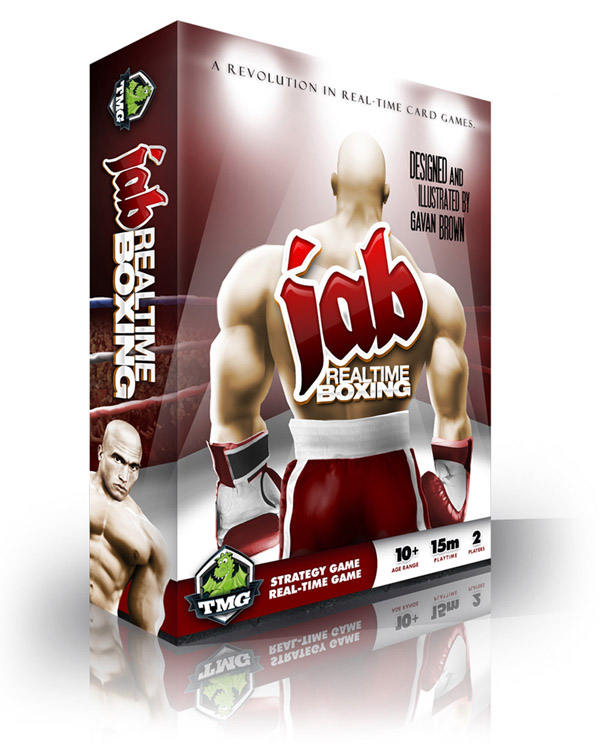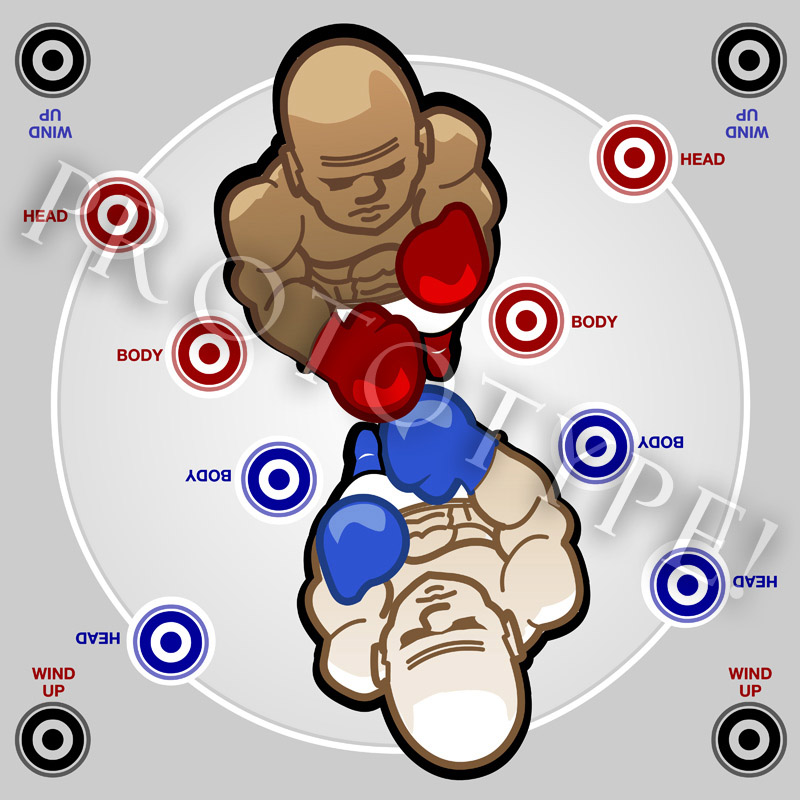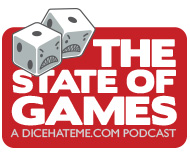A Sweet Science: An Interview with JAB Designer Gavan Brown
For generations, “the sweet science” has always referred to the manly art of fisticuffs; you know, boxing. When I was but a wee lad, I heard the term and immediately imagined a man in a big, white lab coat mixing up ice cream flavors in the lab – such are the machinations of the five-year-old mind. Regardless, for many years of my youth, whenever I would draw I would draw ice cream. Lots and lots of ice cream. Looking back now on all those drawings of ice cream cones, I guess I truly associated art with my personal “sweet science.” All of this is to say that I now have the perfect storm of interpersonal connections* with which to segue into a segment that’s all about “sweet science,” as I recently had a chance to interview the very talented artist and designer behind JAB: Realtime Boxing, Gavan Brown.
*True story, right hand raised high.
For those readers who may not be familiar, can you briefly describe what JAB: Realtime Boxing is all about?
 JAB is a real-time boxing card game, where players are playing punch cards in real-time from 2 punch decks (right side and left side). Players utilize these punch cards to win the game by either winning 3 (of 5 possible) rounds, or by knocking out their opponent, resulting in an instant win. A round is won by scoring more Judge Points than the opposing boxer. With JAB, my goal was to create a [one-on-one] card game system that induced some of the same psychological effects as real-time strategy (RTS) video games.
JAB is a real-time boxing card game, where players are playing punch cards in real-time from 2 punch decks (right side and left side). Players utilize these punch cards to win the game by either winning 3 (of 5 possible) rounds, or by knocking out their opponent, resulting in an instant win. A round is won by scoring more Judge Points than the opposing boxer. With JAB, my goal was to create a [one-on-one] card game system that induced some of the same psychological effects as real-time strategy (RTS) video games.
What, exactly, makes Jab “real time?” What are the special mechanics in the game?
What makes JAB real-time is the fact that there are no turns in the game.
There are a few mechanisms I am very proud of in JAB. The most special mechanism of the game is the open real-time punch system itself (which is I guess more of a trait, than a mechanism). In classic real-time games, the players have very limited “allowed” moves they can perform, and players spend the game looking around for these “allowed” moves. JAB, on the other hand, features an open real-time system, where you can play either of your available punch cards onto any of the 3 opposing boxer’s head and body cards, whenever you want. There are also multiple ways to score points with your punch cards. An open real-time system – combined with multiple ways to score points – creates the effect of players having to think about an overall plan, and how they are going to execute it.
 The punch system in JAB is a fairly non-standard mechanism; players are only allowed to play punch cards from their left punch pile with their left hand, and ditto for the right. This mechanism is really just “chrome” but it does do a lot to make the game feel like boxing. Another non-standard mechanism in the game is the pattern-building combo system. A combo card is a shared objective card that both player may or may not be working towards simultaneously. A combo card has 2-3 types of punches listed on it. If the punches you’ve most recently played to your opponent’s boxer match the punches shown on the combo, you score the combo, which is worth a butt-load of points. A player scoring 3-5 combos in a round will generally win the round, as combos are the main source of judge points.
The punch system in JAB is a fairly non-standard mechanism; players are only allowed to play punch cards from their left punch pile with their left hand, and ditto for the right. This mechanism is really just “chrome” but it does do a lot to make the game feel like boxing. Another non-standard mechanism in the game is the pattern-building combo system. A combo card is a shared objective card that both player may or may not be working towards simultaneously. A combo card has 2-3 types of punches listed on it. If the punches you’ve most recently played to your opponent’s boxer match the punches shown on the combo, you score the combo, which is worth a butt-load of points. A player scoring 3-5 combos in a round will generally win the round, as combos are the main source of judge points.
However, if you make your only objective to score judge points, your opponent may choose to start whittling away at your health, bringing you closer to an instant win. Health and Judge Points are the Yin and Yang of the JAB system; you cannot focus on one and completely ignore the other, or you will undoubtedly lose the game. This Yin and Yang effect is more a meta-game effect, rather than a specific mechanism.
Wow, there’s a lot going on there for a real-time game. How did you come up with the idea for JAB?
JAB‘s inception was a combination of my broad experience with real-time strategy videogames, and my opinion that videogames and boardgames are not as different from one another as people may believe. A real-time strategy videogame is not about what is going on on the screen, but rather what feeling and emotions are created within the player when they play the game. As we all know, the same is true for boardgames… it’s not about the cubes we’re pushing around, it’s about the effects pushing the cubes has. So the challenge then becomes, “how do I create a system that reproduces these specific player psychologies?” rather than “how do I make a boardgame that acts like a videogame?”
In JAB‘s case, the inspiration came from one of my favorite videogames of all time: Fight Night: Round 2. Initially you might be saying well that’s not an RTS game. I actually feel that FNR2 produces psychology so similar to that of an RTS game, that I would actually personally consider FNR2 to be a part of the RTS genre. JAB did not come easily. The first few iterations of the alpha prototype didn’t work at all, and garnered player feedback like “maybe some things just aren’t meant to be board games.” My bull-headedness and persistent belief that the arts of videogame and boardgame design can learn a lot from each other pushed me forward through the early complete failures. The turning point was when I started thinking about how to reproduce player psychologies, rather than thinking about how I could directly port a fighting videogame into a card game. Eventually there was a miracle moment where the game started functioning better than I would have thought possible… and the rest is history. So while FNR2 was the source of inspiration for JAB, the only usable pieces of inspiration it provided me in the end were the theme and the goal to create a game that generated similar emotions.
The first iteration of JAB was played on a board. The game was essentially a bunch of targets to place cards on. The idea was that more powerful punches, such as uppercuts, required that you tap the card on the “wind up” area before placing it on a player target. This version ultimately failed as there needed to be more immediate player goals. I’ve also included an image of the setup of the first working version of the game. You will also notice that each boxer has 4 targets, which made more sense thematically. I made the move to 3 targets, because it allowed me to streamline the combo system, it made the game’s footprint smaller, and it was simply less messy overall.
Do you have any other games in development that you could hint at?
For the last 6 months I’ve been working on a game called Hooch. Hooch is a heavy economic euro-style game where players take on the role of one of the Five Families of New York City during the Prohibition Era. Heavy euros are my favorite type of board game, so I’m extremely thrilled that I’ve finally taken the leap to design one. The game is in late alpha stage, and the core of the game is complete. It features a couple original mechanics that I’ve created, both of which I’m quite happy with. The game is currently being honed, but feels quite promising.
 I’ve also got another real-time game, called YUM: Realtime Icecream (Editor’s note: See? “Sweet Science.” I wasn’t lying!). YUM has been entered into the Canadian Game Design of the Year Awards, and is currently in the top 8 finalists. The other finalists are all amazing games, so it’s very flattering to be included in their ranks. My fingers are crossed.
I’ve also got another real-time game, called YUM: Realtime Icecream (Editor’s note: See? “Sweet Science.” I wasn’t lying!). YUM has been entered into the Canadian Game Design of the Year Awards, and is currently in the top 8 finalists. The other finalists are all amazing games, so it’s very flattering to be included in their ranks. My fingers are crossed.
How did you get involved with Michael Mindes and Tasty Minstrel?
I idle on #bgdf_chat on Mibbit a lot, and have debated many a game design theory with the intelligent Seth Jaffee over the years. He asked me if him and Michael could playtest JAB at BGG.con. I had made it clear to him at the time that I would be publishing JAB myself, but I’d love some feedback. Michael and Seth both really enjoyed JAB, and Michael asked me on several occasions if he could publish it. After a few months of saying “no”, I really started to consider the offer seriously. With a new baby in the house, I eventually realized that the best thing for the game, and my own sanity, was to have Tasty Minstrel Games (TMG) publish it. I’m very happy with the decision. TMG is a publisher with some really modern, outside the box ideas, who greatly values grassroots marketing, which I also happen to think is very important. I love the BoardGameGeek community, and think it’s important to have direct interaction with the end users of the product. What other hobby has such a tightly knit community where you can talk directly to the creator of the product?
What other projects have you been involved with for Tasty Minstrel?
Michael really likes my graphic design. As a result, I’ve had the opportunity to work as Creative Director on a few other TMG projects including Eminent Domain and Train of Thought.
Your graphic design work is outstanding – truly some of the best I’ve seen in years. What is your background in the visual arts?
Why thank you, I really appreciate that coming from a guy who has such a strong sense of brand development himself (I think Dice Hate Me is one of the strongest board game brands out there). I’ve been doing visual art as far back as I can remember. I started out doing a lot of drawing and painting as a child. In my teens I drew a lot of comic book characters. It was my passion. Well that, and videogames. When I was 13 years old, my friends dad “lent” me a copy of Autodesk Animator, where I did a lot of animation. I then taught myself Corel Draw 3, and made business cards for my mom and her friends.
Being an avid PC gamer in the 90s, I learned a lot about computer hardware (configuring IRQs, DMA channels, using EMM386 was no easy task). As such I also learned DOS. Fast-forward to the end of High School, and I had to make a decision: Art or Computers. I ultimately decided to go to Technical College where I got a diploma in Computer Technologies (mostly programming). During my time there, I did not stop desktop publishing, and actually taught myself to use Flash and Photoshop.
I have since worked as a graphic designer and web developer. So to make a short story long, I’ve been constantly involved with graphic design since the age of 13.
What are some of your artistic inspirations?
The best inspiration any artist of any medium can have is other artists. I’m a strong believer in knowing the current fashion of the medium that you work in, whether it’s graphic design, painting or even game design. In the field of game design, this means not only having high knowledge of what other game designers are doing out there, but having the ability to forecast what the next generation of game designs will entail. So for game design inspiration, I play games, I admire games, I deconstruct games, and I think about the player psychologies they create. Same is true of visual design: to gain inspiration, all you have to do is load up your web browser.
I’m part of a design community – dribbble – which features works of the best graphic designers on earth. When I visit that site, I realize that I’m just a small fish in a massive ocean of talent. BoardGameGeek and the Game Artisans of Canada are communities that make me feel the same way about game design.
What are some of your favorite games? How have they influenced you as an artist and designer?
Brass is probably my most favorite, and most played boardgame of all time. Martin Wallace is truly a metagame innovator, as he has shown time and time again. A couple others are the ever popular answers Puerto Rico and Agricola. All three of these games contain an attribute that I will always strive for: they all contain massive amounts of re-playability, and get better and better each time you play them, because of their huge game spaces to be explored. Re -playability is, in my opinion, the most important attribute of any game, second of course to enjoyability. Without re-playability, a good game will never be a great game.
I’d like to thank Gavan for taking the time to run the Dice Hate Me gauntlet. JAB: Realtime Boxing is set to release soon, so keep your eyes peeled for more updates on Dice Hate Me, and a review soon after that!
And for those stalwart few who have stuck around to the very end, I have a special announcement that seems appropriate considering the subject. Dice Hate Me and Roxley (Gavan’s special brand of stunning design) are teaming up to bring you an artier, beefier, better Dice Hate Me store, with a constant influx of new, great, geeky gaming designs and, best of all, a better price! Look for the official announcement on Dice Hate Me in mid-August after I whip the t-shirt gnomes into proper shape.
Related posts:
- Space For More: An Interview With Empires of the Void Designer Ryan Laukat
- Interview Fu – A Chat with Cookie Fu Designer Brian Kowalski
- Ahead in the Clouds – An Interview with Chris James of Stratus Games
- Throwing Stars: An Interview with Ninjato Designers Adam West and Dan Schnake
- Under the Bridge: An Interview with Alf Seegert
Comments
2 Responses to “A Sweet Science: An Interview with JAB Designer Gavan Brown”Trackbacks
Check out what others are saying...-
[…] highly-anticipated deck-builder Eminent Domain, the second edition of Homesteaders (it’s pretty), Jab: Realtime Boxing (finally!) and a preview of the prototype for Kings of Air & Steam (zeppelins and […]







I just played this the other day and I have to say it is a really fun game. It made my lunch hour and is perfect for trash talking your buddy even though he was whooping me like a red-headed stepchild – Great coverage on the mind behind it.